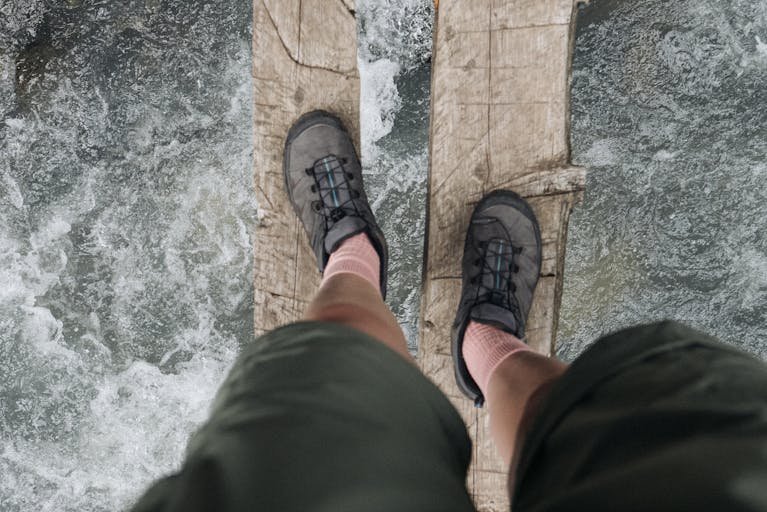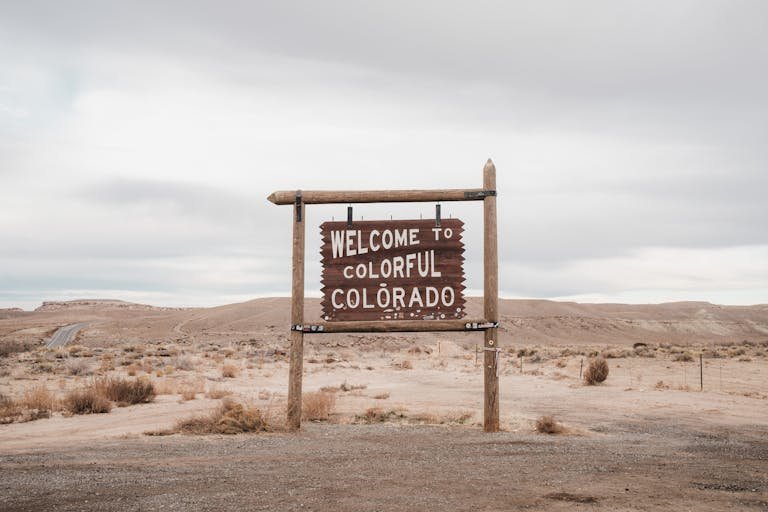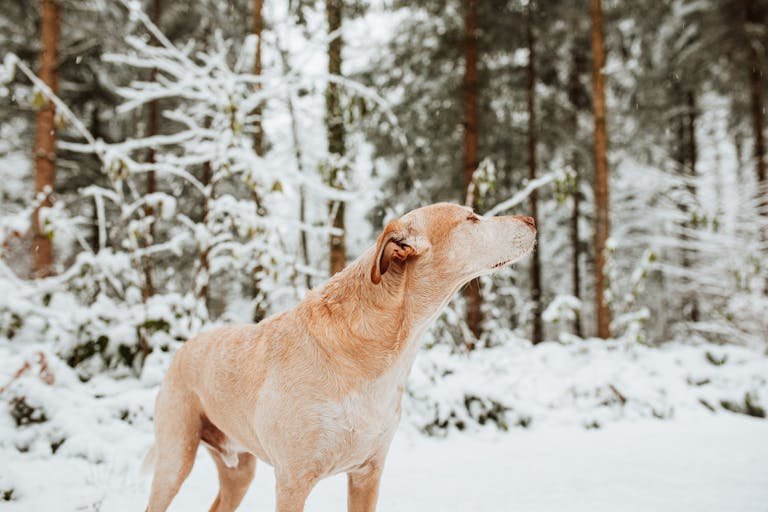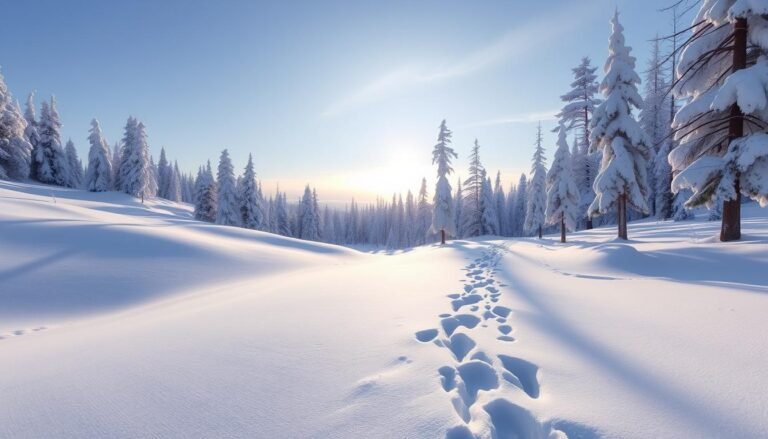Over 10 million people in the United States love winter hiking. They explore snowshoeing trails and face the cold head-on. This shows how popular winter hiking is becoming. It’s a thrilling activity for those who love the outdoors.
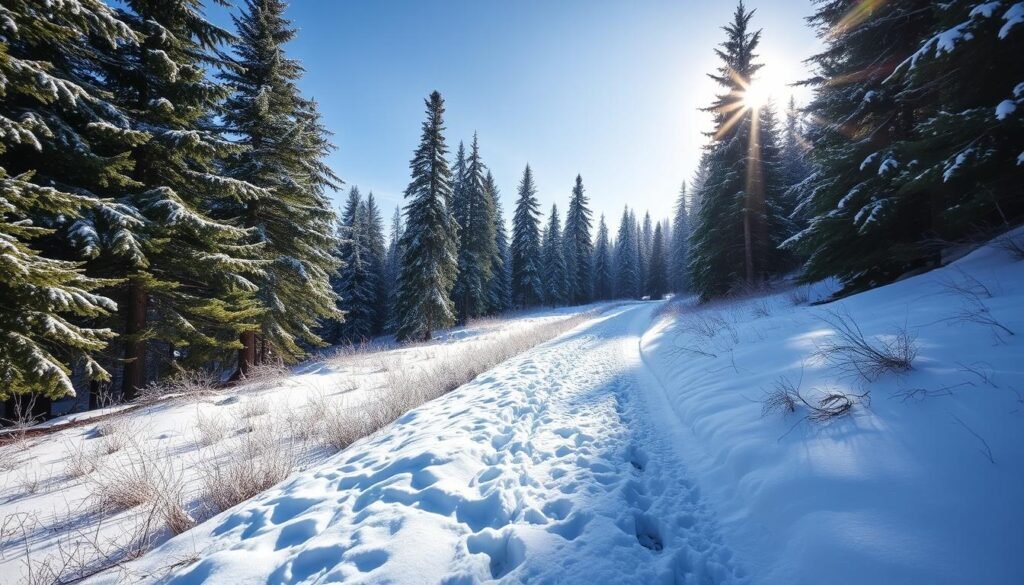
Winter hiking offers beautiful views and exciting challenges. It’s perfect for both experienced hikers and beginners. This guide will help you get ready for your winter hiking adventure. You’ll learn about the right gear, safety, and tips for the cold.
Key Takeaways
- Winter hiking offers a unique and exhilarating experience for outdoor enthusiasts
- Proper gear and safety protocols are essential for a successful winter hiking adventure
- Cold weather hiking tips can help you navigate icy terrain and stay safe
- Winter hiking trails, such as snowshoeing trails, provide a serene and challenging experience
- Understanding the importance of layering and dressing for winter hiking is crucial
- Staying informed about weather conditions and trail closures is vital for a safe and enjoyable winter hiking experience
Understanding Winter Hiking: A Different Kind of Adventure
Winter hiking is a unique adventure compared to other seasons. The cold and snow bring new challenges but also stunning views. To enjoy winter hiking, knowing the benefits and challenges is key.
Winter hiking offers solitude and beautiful scenery. Fewer hikers brave the cold, making trails peaceful. Yet, it comes with harsh weather and dangers like avalanches.
What Makes Winter Hiking Unique
Winter hiking needs special gear like crampons and ice axes. Knowing how to dress for cold and navigate in snow is crucial.
Benefits of Hiking in Winter
Winter hiking has many benefits:
- It’s quieter and more peaceful.
- The scenery is breathtaking, perfect for photos.
- It boosts physical and mental health.
Challenges to Expect
Winter hiking comes with challenges:
- Expect extreme cold and wind.
- Watch out for avalanches and icy paths.
- Visibility can be low, making navigation tough.
To tackle these, having the right gear and knowledge is vital. With the right preparation, winter hiking can be safe and rewarding.
| Winter Hiking Essentials | Description |
|---|---|
| Crampons | Specialized footwear for icy and snowy terrain |
| Ice Axe | Tool for self-arrest and balance on icy slopes |
| Warm and Waterproof Clothing | Essential for cold weather protection |
Winter Hiking Tips
Essential Winter Hiking Gear for Safe Adventures
Winter hiking requires the right gear for a safe and fun trip. The right clothing and equipment are key to navigating snowy trails safely. Each item helps protect you from the cold and potential dangers.
Always carry a first aid kit, an emergency shelter, and a fire starter. These can save your life if you get hurt or lost. Also, choose waterproof and warm clothing and boots to stay dry and cozy.
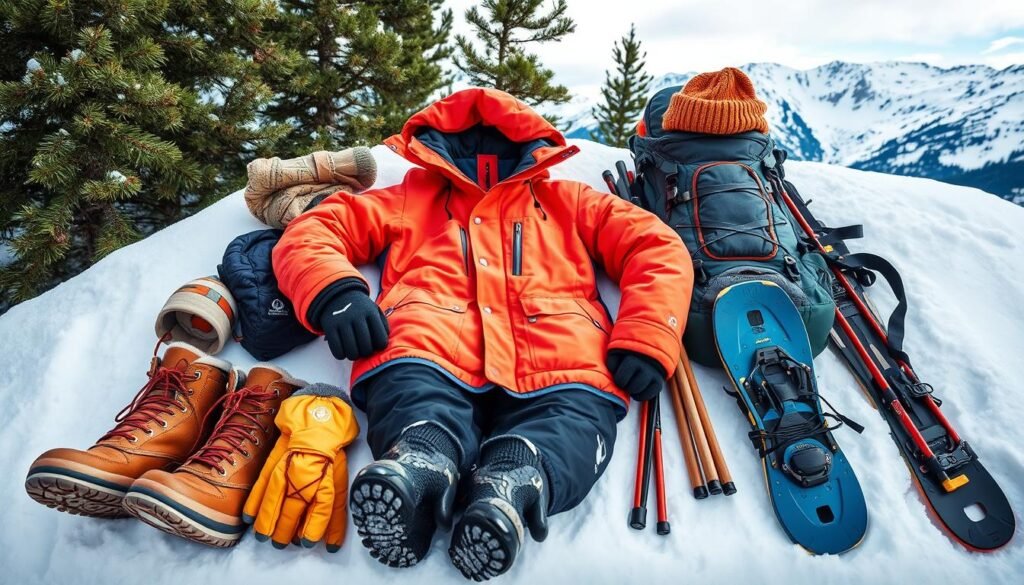
- Insulated, waterproof jacket and pants
- Base layers for temperature regulation
- Warm, waterproof boots with good traction
- Gloves or mittens for hand protection
- Goggles or sunglasses for eye protection
- Avalanche transceiver and probe (if necessary)
By focusing on safety and choosing the right gear, you can enjoy snowy trails. Always check the weather and trail conditions before you go. Also, tell someone your route and when you’ll be back.
Dressing for Success: Winter Hiking Clothing Layers
Dressing in layers is key for winter hiking. It keeps you warm, dry, and comfy. The right gear makes a big difference in your hike.
A good base layer should wick away moisture. Choose merino wool or synthetic materials. Add insulating layers like fleece or down to stay warm. A waterproof outer shell protects you from the weather.
Base Layer Selection
Choosing the right base layer is crucial. Look for breathable, moisture-wicking, and quick-drying materials. Some top picks include:
- Merino wool
- Synthetic materials like polyester or nylon
- Silk or bamboo for extra warmth and comfort
Insulation Techniques
Insulating layers keep you warm. Consider these options:
- Fleece jackets or pants
- Down or synthetic insulated jackets
- Wool or synthetic insulated hats and gloves
Outer Shell Requirements
A waterproof and breathable outer shell is vital. Look for materials like:
| Material | Waterproof | Breathable |
|---|---|---|
| Gore-Tex | Yes | Yes |
| eVent | Yes | Yes |
| Nylon or polyester | Yes | No |
Follow these tips for a safe and fun winter hike. Always put safety and comfort first. Seek advice from experienced hikers or outdoor experts if needed.
Planning Your Winter Hiking Experience
Planning is key for a great winter hike. Start by researching the trail. Look for snowshoeing trails or the best winter hikes in your area. This prep helps you know what to expect and what gear you need.
Always check the weather forecast before you go. This helps you avoid dangers like avalanches or blizzards. Make sure you have the right permits and check for any trail closures.
Some important things to think about include:
- Trail conditions: Look for snow or ice and plan your path.
- Weather forecast: Watch for hazards like avalanches or blizzards.
- Permits and regulations: Get the right permits and check for trail closures.
With good planning, you can have a safe and fun winter hike. Whether you’re looking for snowshoeing trails or the best winter hikes, preparation is key. With the right gear, you can enjoy winter’s beauty.
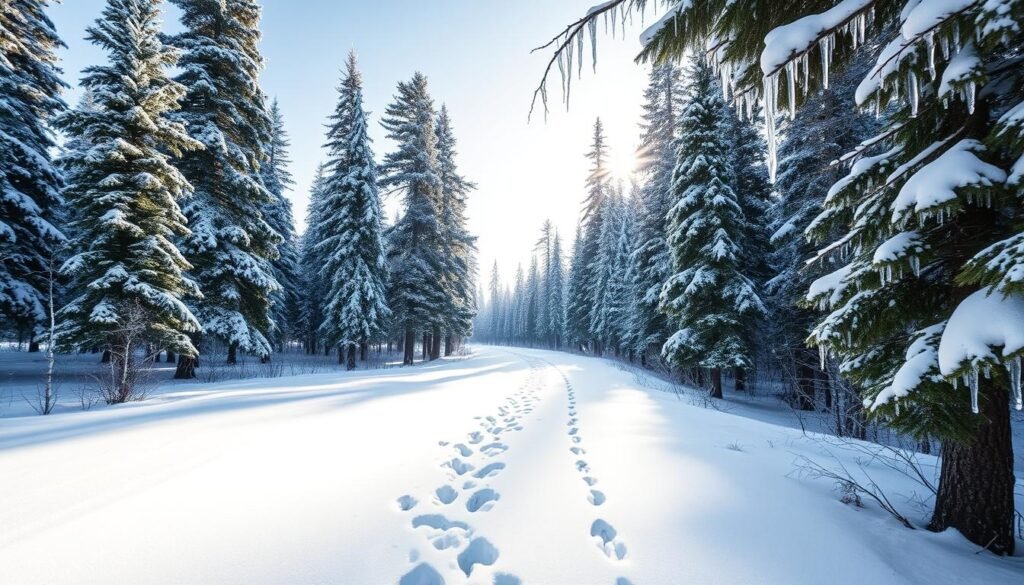
Always put safety first, for yourself and others. With the right planning, your winter hike will be a success.
| Trail | Distance | Difficulty |
|---|---|---|
| Mountain Loop Trail | 10 miles | Moderate |
| Snowshoe Trail | 5 miles | Easy |
| Winter Wonderland Trail | 15 miles | Challenging |
Navigation Skills for Snow-Covered Trails
Winter hiking and snowshoeing trails can be tough to navigate when they’re covered in snow. To stay safe, it’s key to learn how to navigate through the snow. Knowing how to read maps, use GPS, and set waypoints is crucial.
For safe winter hiking, having the right tools and knowledge is vital. This means knowing how to read a map in the snow, using GPS, and setting waypoints. These skills make winter hiking safe and fun.
Map Reading in Winter Conditions
Map reading is a basic skill for winter hiking. It’s important to understand the terrain, including snowshoeing trails and hazards like steep slopes and icy streams. This knowledge helps you stay safe.
GPS and Electronic Navigation Tools
GPS devices and other electronic tools are very helpful in the snow. They help you find your location, track your path, and get back to the start. But, always carry a map and compass too, as a backup.
With strong navigation skills and the right tools, winter hiking is safe and enjoyable. Whether on snowshoeing trails or in the backcountry, knowing how to navigate is key to safety.
Winter Hiking Safety Protocols
Winter hiking is all about safety. It’s key to know how to stay safe on the trails. This includes being ready for emergencies and knowing how to handle dangers like avalanches, hypothermia, and frostbite.
Carrying the right gear is crucial. This includes a first aid kit, emergency shelter, and a way to communicate. Knowing how to use these items is just as important. For instance, a first aid kit should have bandages, antiseptic wipes, and pain relievers. You might also need a lightweight tent or bivy sack for shelter.
Some places, like the Rocky Mountains or the Pacific Northwest, are beautiful but can be dangerous. Always research the area you plan to hike in. Check the weather, trail conditions, and any avalanche risks.
Here are some key winter hiking safety tips to keep in mind:
- Always carry a map and compass, and know how to use them
- Let someone know your itinerary and expected return time
- Stay hydrated and fueled with plenty of water and snacks
- Be aware of your surroundings and watch for signs of hypothermia or frostbite
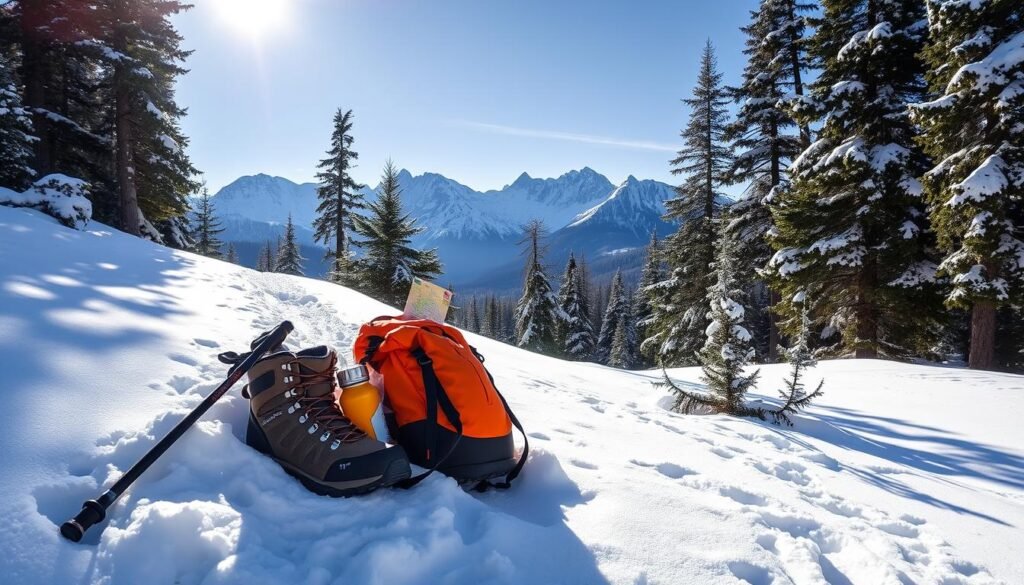
By following these safety tips and being prepared, you can have a great winter hiking adventure. Enjoy the beautiful scenery of your favorite snow hiking destinations safely.
| Winter Hiking Safety Item | Description |
|---|---|
| First Aid Kit | A kit that includes bandages, antiseptic wipes, and pain relievers |
| Emergency Shelter | A lightweight tent or bivy sack to provide protection from the elements |
| Means of Communication | A cell phone or two-way radio to call for help in case of an emergency |
Mastering Snow and Ice Techniques
Winter hiking needs special skills, especially for snow and ice. To stay safe and enjoy snowshoeing trails, knowing how to walk on snow and ice is key. Learning to use microspikes and crampons helps hikers confidently face winter.
Walking on packed snow requires a steady center of gravity and small steps. This is vital on steep or icy slopes to avoid slipping. Also, knowing the snow’s condition helps adjust your steps. For soft snow, take bigger steps to avoid sinking, and for hard snow, smaller steps help stay on track.
Ice Crossing Methods
Crossing ice can be scary, but with the right methods, it’s safe. Using microspikes or crampons adds traction. Another way is to cross at a shallow angle, digging your feet into the ice for balance. Always test the ice first with a probe or pole to check its thickness and stability.
Using Microspikes and Crampons
Microspikes and crampons are must-haves for winter hiking. They provide extra grip on icy and snowy paths. It’s important to follow the maker’s guide and practice using them. This builds confidence and makes hiking safer and more fun. With these techniques and the right gear, winter hiking becomes an adventure full of beauty and ease.
Best Winter Hiking Destinations in America
America is a great place for winter hiking, with many spots for all skill levels. You can hike through snow-covered mountains or enjoy the quiet of the Pacific Northwest. The United States has many exciting trails to explore.
The Northeast is famous for its winter beauty, with states like New York and Vermont. The Rocky Mountains in Colorado and Wyoming offer a tough but rewarding hike. The Pacific Northwest, with Oregon and Washington, is known for its stunning winter views and lots of snow.
- Northeast: Explore the snowy trails of the Adirondacks or the White Mountains
- Rocky Mountains: Discover the rugged beauty of Colorado’s Rocky Mountain National Park or Wyoming’s Grand Teton National Park
- Pacific Northwest: Experience the serene landscapes of Oregon’s Columbia River Gorge or Washington’s Olympic National Park
Whether you’re an experienced hiker or new to it, America has great winter spots. With the right planning, your winter hike will be unforgettable. So, start planning your winter hiking trip today and see America’s snow trails for yourself.
Weather Assessment and Decision Making
Winter hiking requires careful weather assessment and decision-making for safety. It’s important to monitor weather forecasts and trail conditions. This helps in choosing the right route and timing.
Following cold-weather hiking tips is key. Check the weather forecast before you go. Be ready for sudden changes in weather.
When assessing the weather for winter hiking, consider these factors:
- Air temperature and wind chill
- Precipitation and snowfall
- Trail conditions, including ice and snow cover
- Avalanche risk
By carefully assessing the weather, hikers can have a safe and fun experience. Stay updated with weather forecasts and trail conditions. Be ready to return if it gets too dangerous.
Winter hiking can be rewarding, with beautiful views and adventure. With the right knowledge and preparation, it’s a great experience.
Winter hiking safety is everyone’s responsibility. Follow cold weather hiking tips and take necessary precautions. This ensures a safe and enjoyable hike for all.
| Weather Condition | Winter Hiking Safety Precaution |
|---|---|
| Low air temperature | Dress in layers, including a warm hat and gloves |
| High wind chill | Wear a windproof jacket and consider turning back if conditions become too harsh |
| Precipitation and snowfall | Bring a waterproof jacket and consider using trekking poles for stability |
Emergency Preparedness and Response
When you head into the winter wilderness, being ready for emergencies is key. You need a good emergency kit, know how to build a shelter, and have ways to communicate. Being safe while winter hiking is very important, and being ready for emergencies can save your life.
Make sure your emergency kit has the basics:
- First aid supplies
- Navigation tools, like a map and compass
- Shelter materials, like a tent and sleeping bag
- Communication devices, including a cell phone and two-way radio
- Warm clothing and blankets
When choosing snow hiking spots, research the area well. Know about avalanche zones, bad weather, and hard-to-reach places. Being safe and ready for emergencies lets you enjoy snow hiking without risks.
Good communication is crucial in emergencies. Learn how to use your devices, have a plan for emergencies, and stay in touch with your group. Being prepared and knowing how to act in emergencies makes winter hiking safe and fun.
| Emergency Item | Importance Level |
|---|---|
| First Aid Kit | High |
| Navigation Tools | High |
| Shelter Materials | Medium |
| Communication Devices | High |
Conclusion: Embracing the Winter Wilderness
Winter hiking is a journey that changes you. The snow, the air, and the quiet make it special. It lets you see nature’s beauty in a new way.
It’s not just about the views. It’s about growing stronger and feeling refreshed. You learn to face challenges and find pride in your efforts.
To enjoy winter hiking safely, prepare well and stay alert. This guide has all you need to know. So, get ready for your icy adventures and make memories in nature’s winter wonderland.
FAQ’s
What are the key benefits of winter hiking?
Winter hiking offers unique benefits. You get to enjoy solitude and stunning landscapes. It’s also a great way to stay active outdoors during the cold months.
What are the main challenges of winter hiking?
Winter hiking comes with challenges. Harsh weather, like cold and snow, can be tough. You also face a higher risk of injury. But, with the right gear and skills, you can have a safe and fun hike.
What are the essential pieces of gear for winter hiking?
For winter hiking, you need certain gear. This includes base layers and insulating layers. You also need a waterproof outer shell and boots with good traction. Don’t forget gloves, a hat, and essentials like a headlamp and emergency kit.
How can I stay warm and dry while winter hiking?
To stay warm and dry, dress in layers. Use moisture-wicking fabrics and choose waterproof outer layers. The right clothing can greatly improve your comfort.
What safety precautions should I take when winter hiking?
Stay safe by checking the weather forecast. Carry emergency gear like a first aid kit. Be aware of avalanche risks and know how to navigate icy trails. Always let someone know your plans and when you’ll return.
What are some of the best winter hiking destinations in the United States?
Top winter hiking spots in the U.S. include the Northeast, like New Hampshire’s White Mountains. The Rocky Mountains in Colorado and Utah are also great. The Pacific Northwest, with trails in Washington and Oregon, is another favorite.
How do I plan a successful winter hiking trip?
Planning is key for a successful winter hike. Research trails and check the weather. Get the necessary permits and pack the right gear. Make sure you have navigation and emergency skills.
What techniques should I use for navigating snow-covered trails?
For snow trails, use map reading and GPS. Learn to spot trail markers. Knowing how to navigate in winter is crucial for safety.
How do I respond to emergencies or unexpected situations while winter hiking?
Being ready for emergencies is vital. Carry an emergency kit and know how to build a shelter. Have a communication plan. Stay calm and follow protocols to handle unexpected situations.




